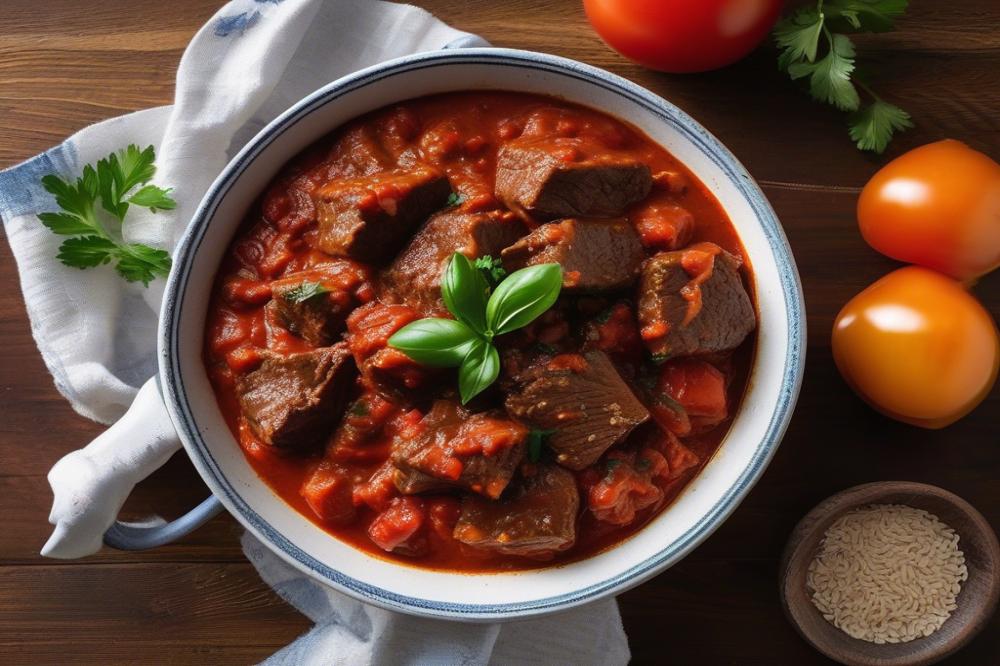How to Cook Traditional Greek Kokkinisto Beef in tomato sauce
Kokkinisto Beef is a beloved traditional Greek dish that holds a special place in many hearts. This hearty meal is packed with flavor and comfort, making it a staple at family gatherings and Sunday dinners. With each bite, the rich tastes of slow-cooked beef accompanied by aromatic spices transport you straight to Greece.
Tomato sauce plays a crucial role in Greek cuisine. It adds depth and vibrancy, transforming ingredients into something extraordinary. Many classic dishes, like moussaka and pastitsio, rely on the delicious blend of tomatoes and herbs. In the case of Kokkinisto Beef, the sauce envelops the meat, infusing it with warmth and a savory touch.
Beef stew is a prominent feature of the Mediterranean diet. Many cultures in this region enjoy slow-cooked meals that prioritize fresh, wholesome ingredients. This style of cooking not only brings families together but also highlights the importance of homemade dishes that can be cherished for generations. Each family recipe carries with it a story, often passed down from grandmothers and mothers.
The purpose of this article is to guide you through the process of creating this amazing dish at home. From choosing the right beef to mastering the tomato sauce, you will be prepared to serve a classic Greek recipe that your loved ones will savor. Let’s explore how to make this comforting dish and enjoy a taste of Greece in your very own kitchen!
Kokkinisto Beef Ingredients and Cooking Instructions
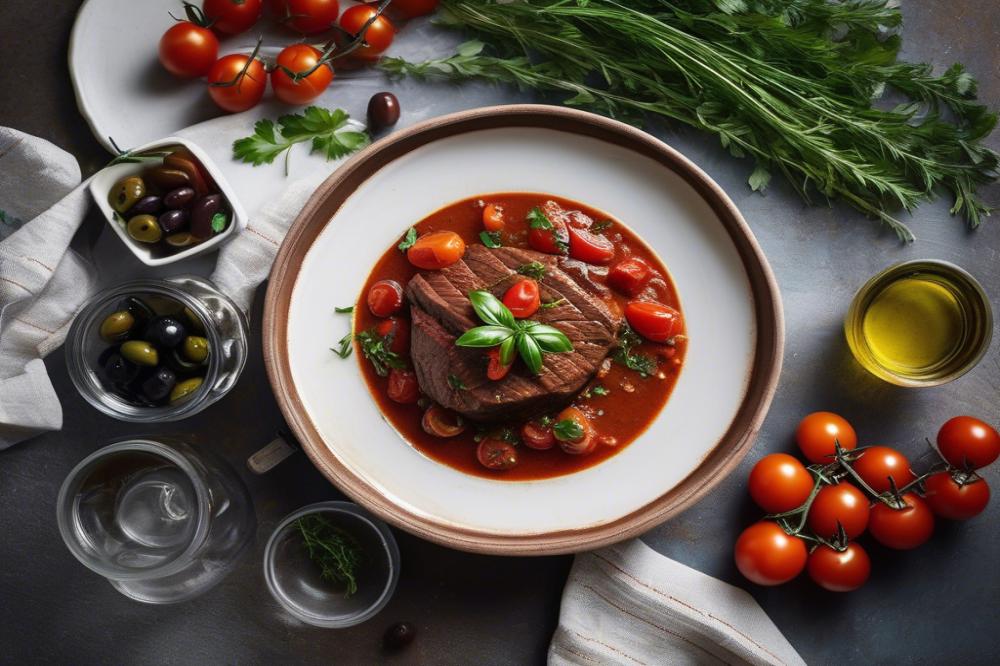
Ingredients
- 2 pounds of beef chuck, cut into 1½-inch cubes
- 3 tablespoons olive oil
- 2 large onions, finely chopped
- 4 garlic cloves, minced
- 2 medium carrots, sliced
- 1 can (14 ounces) diced tomatoes
- 2 cups beef broth
- 1 tablespoon tomato paste
- 1 teaspoon dried oregano
- 1 teaspoon ground cinnamon
- Salt and pepper to taste
- Fresh parsley for garnish
Cooking Instructions
Begin by heating the olive oil in a large pot or Dutch oven over medium heat. Add the chopped onions and sauté until they become translucent, which takes about 5 minutes. Next, incorporate the minced garlic and sliced carrots, cooking for an additional 2 minutes to soften them slightly.
Once the vegetables are ready, add the beef cubes to the pot. Brown the meat on all sides, ensuring it gets a nice crust. This process usually takes around 10 minutes. After the beef is browned, stir in the diced tomatoes, beef broth, and tomato paste. Sprinkle in oregano and cinnamon, along with salt and pepper.
Allow the mixture to come to a simmer. Cover the pot and reduce the heat to low. Cook this hearty stew for at least 2 to 3 hours. This method of slow cooking allows the flavors to meld beautifully and makes the beef incredibly tender. Stir the stew occasionally during this time so that it does not stick to the bottom.
To give it a boost of flavor, many cooks recommend tasting the stew occasionally. Adjust the seasoning to your preference as it cooks. If using, sprinkle fresh parsley on the dish right before serving for that extra touch.
Tips for Great Flavor
Choosing quality ingredients is essential. Fresh vegetables and good meat make a considerable difference in taste. Allowing ample time for slow cooking enhances flavors, so avoid rushing the process. Additionally, consider marinating the beef in red wine overnight. This step not only adds a depth of flavor but also tenderizes the meat.
You can also play with flavors by adding other herbs or spices, such as bay leaves or allspice. Keeping the heat low prevents burning, so patience is key. The longer the stew simmers, the better it will taste.
Suggested Side Dishes
This traditional Greek dish pairs well with various sides. Serving it alongside boiled potatoes or rice can complement the rich sauce. You might also try a light Greek salad with cucumbers, tomatoes, and feta cheese. The freshness of a salad balances the hearty meal beautifully.
A slice of crusty bread is excellent for soaking up the delicious tomato sauce. Consider also serving a side of roasted vegetables for added nutrition. Each of these options enhances the overall dining experience and embodies the principles of the Mediterranean diet.
Nutritional Information
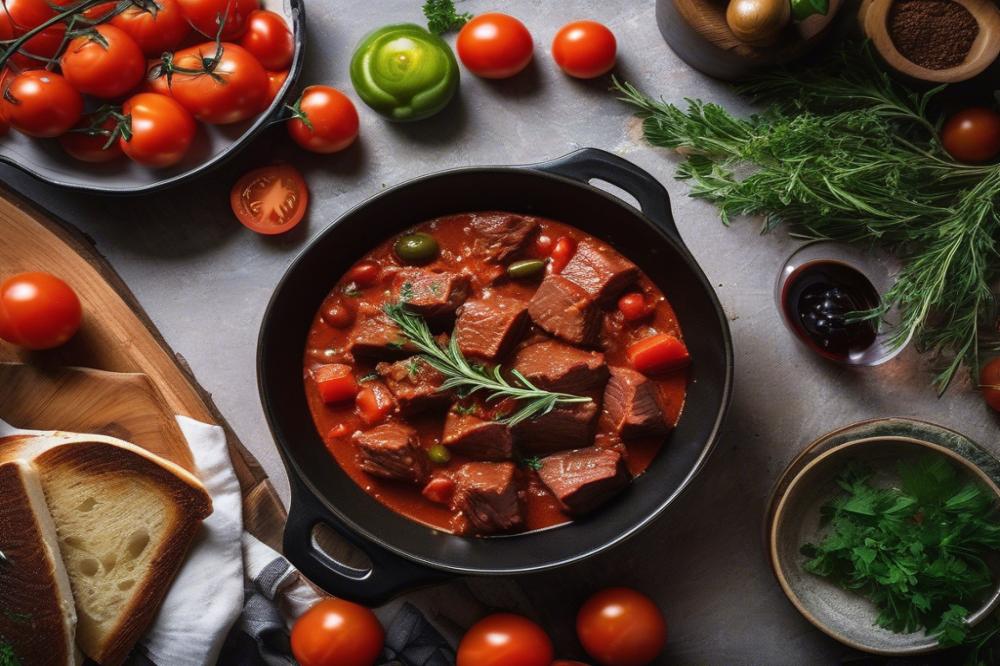
Understanding the nutritional value of each ingredient helps appreciate the dish even more. Beef is a main component in this traditional Greek dish. It provides essential proteins and minerals like iron and zinc. Tomato sauce adds vitamins, particularly vitamin C and lycopene, an antioxidant. Onions and garlic, typically included in the recipe, enhance flavor and have health benefits. Seasoning with spices such as cinnamon and allspice can contribute to overall wellness as well.
Beef serves as a primary source of protein, which is crucial for muscle growth and repair. Additionally, it offers B vitamins that support energy production. Cooking beef stew over low heat allows for better absorption of flavors and nutrients. Slow cooking also makes the meat tender and easier to digest, making this hearty meal comforting and satisfying. Well-balanced meals should include protein, healthy fats, and carbohydrates to nourish our bodies effectively.
Impact of a Mediterranean Diet on Overall Health
The Mediterranean diet is well-known for promoting good health. It emphasizes whole foods, including fruits, vegetables, whole grains, and healthy fats. Incorporating these elements can lead to a reduced risk of chronic diseases. Products like olive oil are heart-healthy fats that can replace saturated fats commonly found in processed foods. Studies frequently link this dietary pattern to lower blood pressure and cholesterol levels. Eating fresh produce along with a beef stew results in balanced nutrition.
Considerations for Portion Sizes
When enjoying comfort food like Kokkinisto beef in tomato sauce, portion sizes matter. A well-balanced plate might include one serving of beef and two servings of vegetables. This balance helps maintain a healthy caloric intake. It’s common to savor this dish with some bread or rice, but moderation is essential. Overindulgence can counteract the health benefits associated with a Mediterranean diet. Keeping everything in check encourages a healthy lifestyle and leads to enjoyable family meals.
Cultural Significance of Kokkinisto Beef
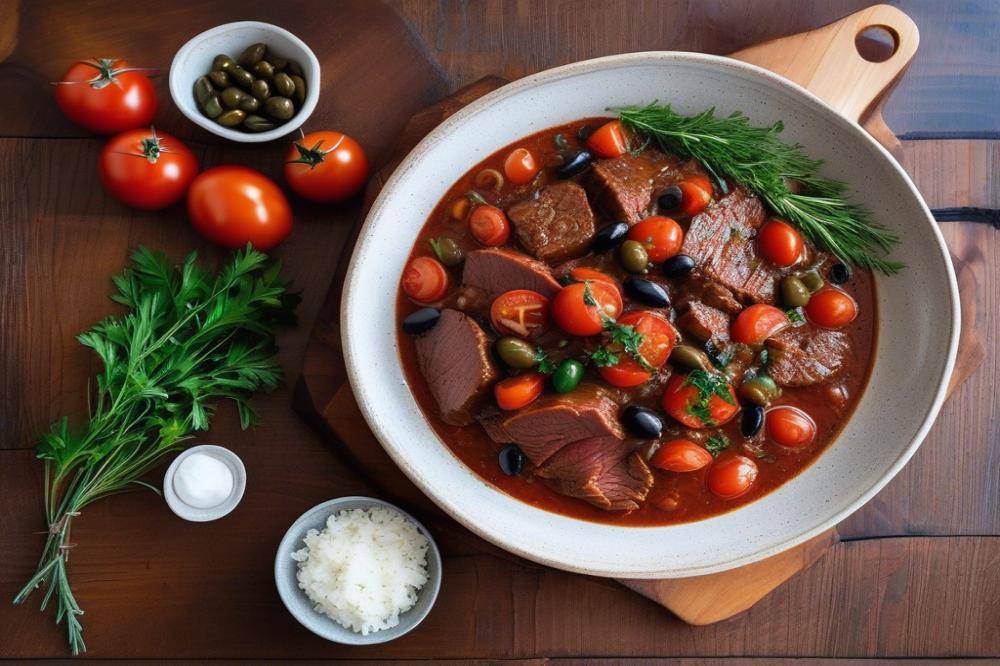
The traditional Greek dish known as Kokkinisto Beef holds a special place in the heart of Greek culture. Its origins can be traced back centuries, influenced by the Mediterranean diet and the bounty of local agriculture. This beef stew is not just a meal; it is a representation of family and tradition, often shared during special occasions.
Greek cuisine varies widely across different regions. Some areas might add distinct spices or local vegetables to their tomato sauce. In Crete, for example, cooks may use locally sourced herbs to enhance the flavor. Meanwhile, in the mainland, you can find recipes that lean towards a richer, more robust sauce. Each variation reflects the local ingredients and traditions, making every family’s approach to the dish unique.
This dish connects families through generations. Many recipes are passed down, becoming cherished family heirlooms. When preparing it, families often reminisce about past gatherings. Cooking Kokkinisto is more than just preparing a hearty meal; it is about creating memories together. Homemade meals like this strengthen bonds among loved ones.
During holidays and gatherings, Kokkinisto Beef is a staple. Greek families enjoy this comfort food during festive meals, especially around Christmas and Easter. Its warmth and rich flavors make it perfect for sharing. Guests often look forward to enjoying this dish, knowing it comes with love and tradition.
As it simmers slowly on the stove, the aroma fills the home, inviting everyone to gather around the table. Children watch and learn from their parents, eager to carry on the family recipe. Each bite offers comfort and nostalgia, tying individuals back to their roots in Greece.
Serving and Storing Kokkinisto Beef
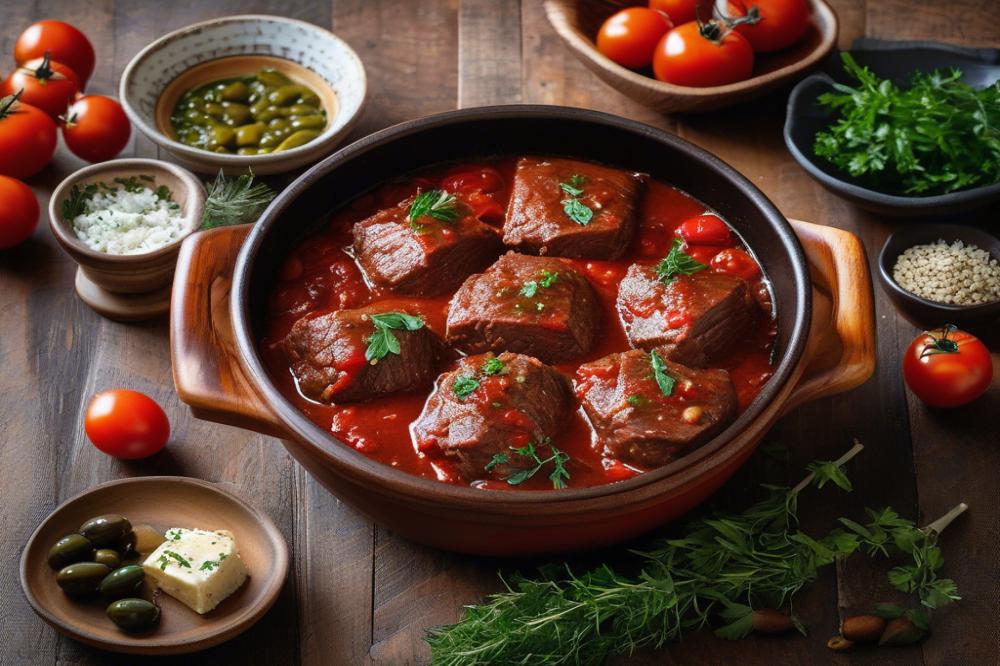
Best Practices for Serving Kokkinisto Beef
Kokkinisto beef is best enjoyed warm, straight from the pot. Place the stew in a large serving dish to highlight its vibrant color. When serving, it’s ideal to ladle some of the rich tomato sauce over the meat. This adds visual appeal and enhances flavor. A sprinkle of fresh parsley or crumbled feta cheese on top can provide an aromatic touch.
Recommended Accompaniments
Traditional Greek cuisine often pairs this hearty meal with comforting sides. Rice makes an excellent choice, soaking up the delicious sauce. Another popular option is crusty bread, perfect for dipping and savoring every bite. For additional flavor, consider a simple Greek salad on the side. Fresh veggies and tangy dressing complement the richness of the beef stew, creating a balanced plate.
Storage Tips for Leftovers and Reheating Guidelines
Storing leftover kokkinisto beef requires careful attention. Allow the meal to cool before transferring it to an airtight container. It can stay in the refrigerator for up to three days. Reheating is simple. Use the stove or microwave until warm; just be cautious not to overheat, as this can dry out the meat. A splash of water or extra tomato sauce can help keep it moist while reheating.
Freezing Options for Future Meals
For longer storage, freezing is a great option. Ensure the beef stew is completely cool before placing it in a freezer-safe container. It can last for up to four months in the freezer without losing its flavor. When ready to enjoy again, thaw it overnight in the fridge. Reheat as mentioned earlier, and you will have a delicious homemade meal ready to go, embodying the essence of the Mediterranean diet and comfort food.
Wrapping Up the Flavor Journey
Kokkinisto Beef holds a special place in Greek cuisine. This traditional Greek dish is more than just a meal; it represents warmth, family gatherings, and cherished memories. The rich flavors of beef cooked in a savory tomato sauce create a comforting experience in every bite.
Cooking this dish at home is a delightful way to embrace Greek culture. Crafting it from scratch allows you to appreciate the time and care that goes into preparing such comfort food. Each step in the cooking process invites you to connect with the ingredients and the history they carry.
Trying Kokkinisto Beef in your kitchen can be a rewarding adventure. You might discover new cooking techniques or flavors you never expected. Sharing this meal with friends and family can lead to lively conversations and happy moments around the table.
Exploring more classic Greek recipes expands your culinary horizons. The Mediterranean lifestyle offers a variety of healthful and delicious options. Each dish tells a story and invites you to enjoy the simple pleasures of life. Embrace the flavors, the traditions, and the joy of cooking as you dive deeper into this vibrant cuisine.

